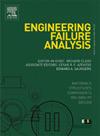基于厚度效应的铝合金厚板裂纹扩展行为及寿命预测模型研究
IF 4.4
2区 工程技术
Q1 ENGINEERING, MECHANICAL
引用次数: 0
摘要
飞机的主要承重部件主要由厚截面铝合金结构构成。在这些应用中,厚度效应是影响铝合金厚板裂纹扩展寿命的关键因素。因此,在损伤容限设计过程中考虑厚度效应是十分必要的。本文采用三种不同厚度的7050-T7451铝合金试样,研究了厚度对裂纹扩展寿命的影响。根据实验结果,定量表征了厚度效应对裂纹扩展寿命的影响。同时,揭示了裂纹扩展速率与裂纹长度之间的双线性关系。在此基础上,通过有限元分析与python计算算法的协同集成,提出了考虑厚度效应的裂纹扩展寿命预测模型。最后,对裂纹扩展阶段观察到的局部瞬时断裂现象及其对表面裂纹扩展行为的影响提供了机理见解。本文章由计算机程序翻译,如有差异,请以英文原文为准。
Investigation of crack propagation behavior and life prediction model of aluminum alloy thick plate based on thickness effect
The main load-bearing components of aircraft are predominantly constructed from thick-section aluminum alloy structures. In these applications, the thickness effect is a critical factor significantly influencing the crack growth life of aluminum alloy thick plates. Therefore, it is essential to incorporate the thickness effect into the damage tolerance design process. In this paper, the 7050-T7451 aluminum alloy specimens with three distinct thicknesses were utilized to investigate the effect of thickness on the crack growth life. The deviation of crack growth life caused by the thickness effect was quantitatively characterized based on experimental results. Meanwhile, the bilinear relationship between the crack growth rate and crack length was revealed. Furthermore, a modified crack growth life prediction model incorporating the thickness effect was proposed through the synergistic integration of finite element analysis and Python-based computational algorithms. Finally, mechanistic insights into the localized instantaneous fracture phenomenon observed during the crack propagation stages and its influence on surface crack propagation behavior were provided.
求助全文
通过发布文献求助,成功后即可免费获取论文全文。
去求助
来源期刊

Engineering Failure Analysis
工程技术-材料科学:表征与测试
CiteScore
7.70
自引率
20.00%
发文量
956
审稿时长
47 days
期刊介绍:
Engineering Failure Analysis publishes research papers describing the analysis of engineering failures and related studies.
Papers relating to the structure, properties and behaviour of engineering materials are encouraged, particularly those which also involve the detailed application of materials parameters to problems in engineering structures, components and design. In addition to the area of materials engineering, the interacting fields of mechanical, manufacturing, aeronautical, civil, chemical, corrosion and design engineering are considered relevant. Activity should be directed at analysing engineering failures and carrying out research to help reduce the incidences of failures and to extend the operating horizons of engineering materials.
Emphasis is placed on the mechanical properties of materials and their behaviour when influenced by structure, process and environment. Metallic, polymeric, ceramic and natural materials are all included and the application of these materials to real engineering situations should be emphasised. The use of a case-study based approach is also encouraged.
Engineering Failure Analysis provides essential reference material and critical feedback into the design process thereby contributing to the prevention of engineering failures in the future. All submissions will be subject to peer review from leading experts in the field.
 求助内容:
求助内容: 应助结果提醒方式:
应助结果提醒方式:


